BFG's GeForce FX 5900XT OC
Testing Setup / Aquamark and Halo Benchmarks
|
We tested these cards on an i865PE "Springdale" based Asus P4P800 Deluxe motherboard, powered by an Intel
|
Common System Hardware: Asus P4P800 Deluxe (i865PE) Motherboard Intel Pentium 4 2.4GHz CPU / 800MHz FSB 512MB (256MB x2) Kingston HyperX PC3500 DDR Western Digital 20GB Hard Drive Lite-On 16X DVD-ROM
Software / System Drivers: |
|
| Aquamark 3 comes to us by way of Massive Development. Massive's release of the original Aquanox in 1999 wasn't very well received by the gaming community, but it was one of the first games to implement DX8 class shaders, which led to the creation of Aquamark 2 - a benchmark previously used by many analysts. Since the Aquamark benchmarks are based on an actual game engine, they must support old and new video cards alike. Thus, the latest version of Aquamark, Aquamark 3, utilizes not only DirectX 9 class shaders, but DirectX 8 and DirectX 7 as well. We ran this benchmark at resolutions of 1024x768 and 1600x1200 with no anti-aliasing, and again with 4x AA. |


As we have already tested the Pixelview 5900XT model just a week prior, we will pretty much know what to expect with the majority of these benchmarks. By the same token, it would be safe to say that we will generally expect that BFG's version of the 5900XT that comes pre-overclocked to 430MHz/735MHz will outperform the standard model by some degree. So, without further ado, our first benchmark, AquaMark 3 gave us predictable results. The two 5900XT models are at the fore-front, with the 9600XT and 5700 Ultra trailing behind. In all instances, BFG's card came out about 7-8% higher than the stock e-VGA model, which falls in line directly with the 7.5% increase in speed.
|


Our look at Halo offered up pretty much the same results; 5900XT models at the top, the other two cards battling it out for third place. ATi has actually made some strides with the new Catalyst 4.6 drivers, increasing performance slightly than what we've seen in the past, and enabling it to take a 9-10% lead over the 5700 Ultra. In the battle for the top spot, we've got the BFG 5900XT OC over the e-VGA 5900XT by 3 frames at 1024x768 and just over a frame at 1600x1200. The percentage difference was right on at 7.5% for the first benchmark, but slipped slightly to only over 3% at the higher resolution.








